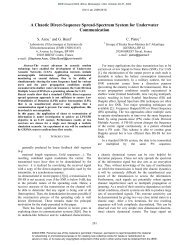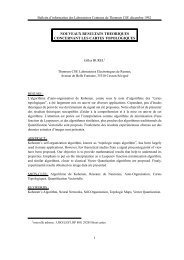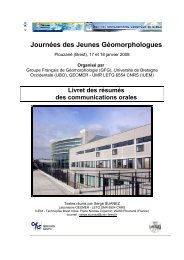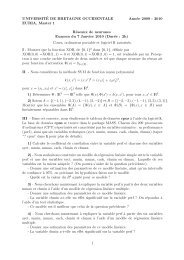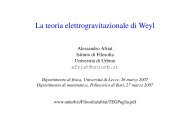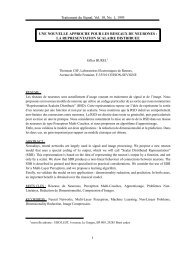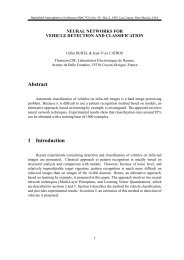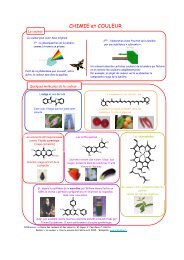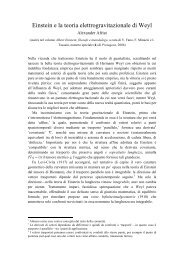Duhem, Quine and the other dogma
Duhem, Quine and the other dogma
Duhem, Quine and the other dogma
- No tags were found...
You also want an ePaper? Increase the reach of your titles
YUMPU automatically turns print PDFs into web optimized ePapers that Google loves.
<strong>Duhem</strong>, <strong>Quine</strong> <strong>and</strong> <strong>the</strong> o<strong>the</strong>r <strong>dogma</strong> 5<br />
But since <strong>the</strong> leap from an object to a truth-value 15 is considerable, this seems an<br />
unnatural extension—however justified within his scheme—of <strong>the</strong> nomenclature<br />
first adopted for words.<br />
Attempting, <strong>the</strong>n, a natural extension of <strong>the</strong> meaning-reference distinction from<br />
words to sentences, I suggest that a single experiment O provides not <strong>the</strong> meaning<br />
of a sentence—for <strong>the</strong> reasons urged by <strong>Quine</strong>—but something more like<br />
its ‘reference.’ With <strong>the</strong> analogy between experiments <strong>and</strong> physical objects in<br />
mind I propose, <strong>the</strong>n, to say that a sentence W refers to a specific experiment—<br />
to experiment O 1 with features F 1 = { ¯F , F1 1 , F2 1 , . . .} or to O 2 with features<br />
F 2 = { ¯F , F1 2 , F2 2 , . . .} or to O 3 etc.—<strong>and</strong> that its meaning is given by <strong>the</strong> subset<br />
¯F of ˆF = ⋂ F i that corresponds to W by expressing an ideal experimental intention,<br />
an abstract logical core. It is up to <strong>the</strong> ingenuity of <strong>the</strong> experimenters to<br />
reduce ˆF to ¯F by producing enough experiments, with sufficiently varied auxiliary<br />
assumptions. Or ra<strong>the</strong>r <strong>the</strong> experimenters begin with <strong>the</strong> experimental intention ¯F<br />
expressing W , <strong>and</strong> <strong>the</strong>n go about finding many different ways to implement it<br />
physically. The trouble is that ¯F is a tenuous, ideal object, which cannot be performed<br />
on its own; auxiliary features 16 of some kind or o<strong>the</strong>r are needed to realise<br />
it, to bring it about. <strong>Quine</strong>’s point is roughly that W cannot be determined empirically<br />
because its counterpart ¯F cannot be carried out alone, without accidental<br />
auxiliary features, which <strong>the</strong>n confuse <strong>the</strong> logic of <strong>the</strong> experiment by unavoidable<br />
entanglement with ¯F .<br />
The various experiments could agree or disagree. Disagreement complicates<br />
matters; for <strong>the</strong>n which are to be trusted Would <strong>the</strong> majority, or perhaps some<br />
privileged experiment or subclass of <strong>the</strong>m, necessarily be right To avoid such<br />
complications unanimity will be required: <strong>the</strong> experiments must all yield <strong>the</strong> same<br />
verdict. 17 It will <strong>the</strong>n be claimed that, taken toge<strong>the</strong>r, <strong>the</strong>y are crucial. Such ‘cruciality’<br />
rests on <strong>the</strong> variety <strong>and</strong> prior plausibility of <strong>the</strong> auxiliary assumptions.<br />
Variety guarantees independence—for if <strong>the</strong> assumptions resemble each o<strong>the</strong>r too<br />
much, agreement will be no surprise 18 —<strong>and</strong> prior plausibility is inherited from<br />
o<strong>the</strong>r contexts. So I will assume that <strong>the</strong> validity of every auxiliary assumption Fb<br />
a<br />
made in each experiment O a was established in several o<strong>the</strong>r experimental contexts<br />
{O b1 , O b2 , . . .}; <strong>and</strong> fur<strong>the</strong>rmore that validity so established is maintained<br />
in <strong>the</strong> particular experiment O a ; a, b = 1, 2, . . . . The unanimity of <strong>the</strong> verdict<br />
cannot <strong>the</strong>n be reasonably attributed to a conspiracy of <strong>the</strong> auxiliary assumptions<br />
{F1 1 , F2 1 , . . .}, {F1 2 , F2 2 , . . .}, . . . ; it must be due to <strong>the</strong> experimental intention ¯F .<br />
Ano<strong>the</strong>r approach, adopted by Grice <strong>and</strong> Strawson ([27] p.156) in response to<br />
15 Admittedly an object of sorts too, but a very particular one.<br />
16 Auxiliary features <strong>and</strong> assumptions seem closely related enough to justify conflation.<br />
17 Perhaps disagreement is more common or likely than agreement; but unanimous agreement remains<br />
possible none<strong>the</strong>less.<br />
18 As has been pointed out to me by John Earman <strong>and</strong> John Norton. The st<strong>and</strong>ard resources of<br />
confirmation <strong>the</strong>ory, such as probabilities, have been deliberately avoided here.



